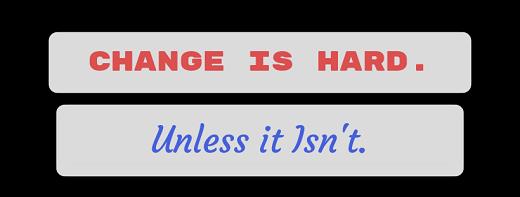The “facts” of fitness aren’t hard to figure out. The “how” is relatively easy to access. It’s available in countless books, websites, and apps. But it’s long, hard, and boring. So a lot of people struggle.
The perception that to get in shape, you have to give up everything that tastes good and is fun, doesn’t sit well with most people.
Countless studies have shown clearly that when given a choice between a smaller reward now (for example, cookies and a movie on the couch) and a larger reward later (for example, better fitness), people most often choose the immediate reward.
The result is that the “pain” of giving up favorite junk foods or sacrificing couch time for workout time is greater than the less tangible, more abstract, far off “pleasure” achieved from hitting fitness goals that are months or even years away.
Do People Hate Change?
Lots of people have babies. Multiple times. And most often on purpose! There might be no more inconvenient change than the changes necessary to accommodate a child in your life. Clearly, change can be welcomed and embraced, even when it is very inconvenient. Why?
What’s different about the change of having a baby vs. the change of sticking with exercise?
The drive and desire – the motivation – to make the change (have a child) outweighs the desire to stay with the same situation (not have a child.) And this provides the formula for success with any change, including fitness. Start with the desired change; discover the powerful emotional reasons why the change matters, and then start to work on how.
This is why the emphasis in Funtensity is on the reactivity, coordination, partner interaction, and friendly competition. You’re having so much fun you don’t notice how hard you’re working until you stop.
Most people hate being aware of the intensity required for physical change with exercise.
From What to Why
The actual workout of a workout program should be the last thing you figure out. First, ask “what” until you get deep enough to make the goals specific, relevant, and meaningful. For example, if you start with a goal of “get in shape,” that’s too vague and meaningless to be powerful. Keep asking questions like “What will be different in my life when I get in shape?” and “What does ‘get in shape’ mean to me?” until you get the detail you need.
And if you don’t ask, you’ll never activate the powerful emotional components of motivation that help you work around life’s endless parade of challenges to fitness success.

